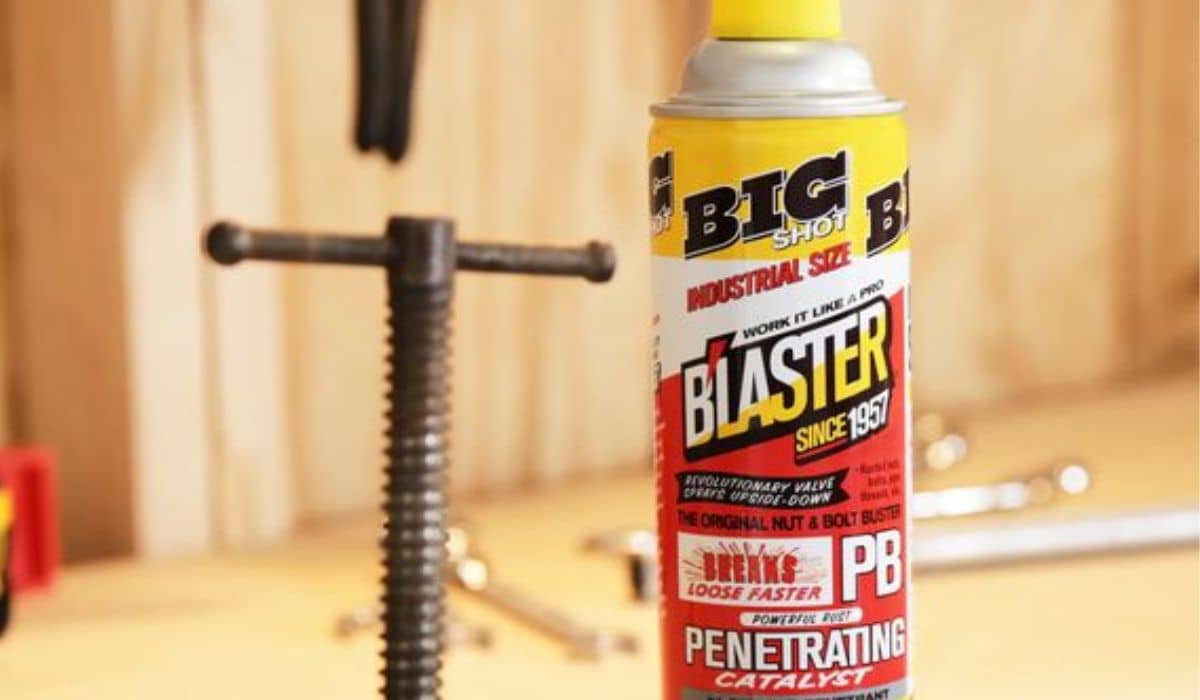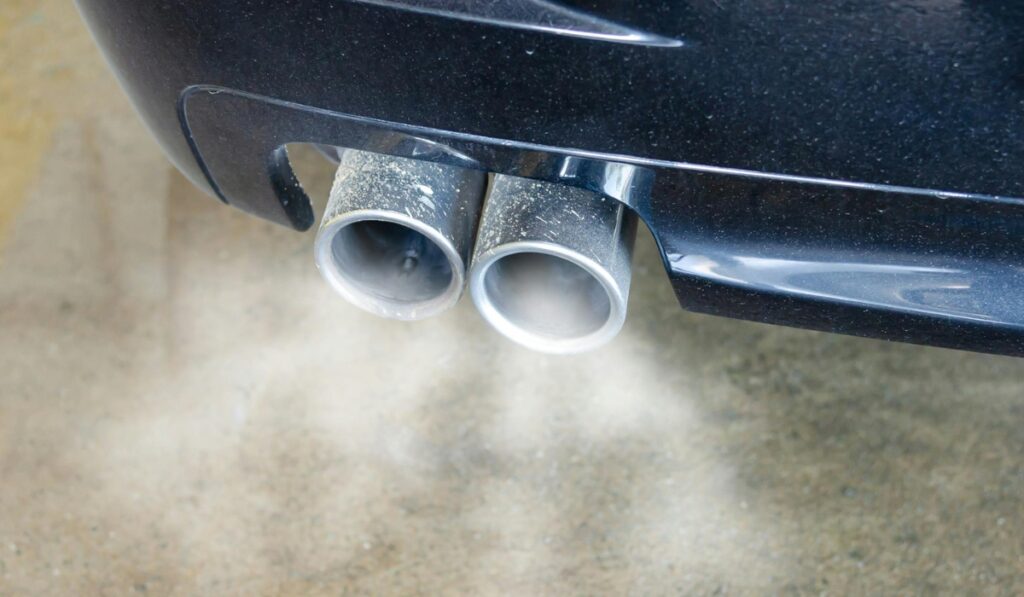WD-40 and PB Blaster are both popular penetrating oils, but they have some notable differences. WD-40 is water-displacing spray that was originally developed in 1953 to prevent corrosion by displacing water.
It also has lubricating properties that allow it to “penetrate” stuck parts. PB Blaster is a more modern penetrating and lubricating oil first sold in 1957. It uses a different formula focused on “blasting away” rust and corrosion. Let’s discuss WD-40 vs PB Blaster.
What is WD-40?
WD-40 is a light oil-based multi-use product with a variety of household and industrial uses. The name stands for “Water Displacement, 40th formula” as it was the 40th attempt to create a water displacing spray.
WD-40 is manufactured by the WD-40 Company based in San Diego.
It was originally used by aerospace companies in the 1950s to coat Atlas missile parts and prevent corrosion. WD-40 was first sold to consumers in 1958 and quickly became popular for its ability to “penetrate” stuck parts and hinges while protecting metal from rust and other corrosion.
Key Features of WD-40:
- Light oil formula quickly penetrates gaps and loosens stuck, binding, or rusty parts
- Displaces moisture to prevent corrosion and lubricate parts
- Protects metal surfaces with anti-corrosive agents
- Can penetrate tight spaces and provide short-term lubrication
- Safe on most plastics and rubber
Applications of WD-40:
- Loosening stuck nuts, bolts, door hinges, valves, chains, and other mechanisms
- Protecting tools, equipment, and metal parts from rust
- Lubricating hinges, springs, wheels, fans, and more
- Displacing moisture in electrical systems
- Cleaning dirt, oil, grease, tar, and other substances
How WD-40 Works:
The key to WD-40’s effectiveness is its ability to quickly penetrate tight spaces between parts. It contains a non-viscous carrier fluid as well as light lubricating oils and anti-corrosion additives.
The carrier fluid is able to get deep into stuck or jammed joints and mechanisms. It also spreads the lubricants and protectants into crevices.
The lubricating agents reduce friction while the anti-corrosion components coat the metal surfaces. This works to both free up parts and protect them from rust and wear.
The fluid nature also allows it to displace water, helping break down rust. WD-40 then evaporates quickly, leaving the lubricants and corrosion inhibitors behind.
Limitations:
While useful in many applications, WD-40 does have some limitations. It is designed primarily for penetration and water displacement rather than as a heavy duty lubricant. It can evaporate and wear off, requiring reapplication.
The light formula means it runs off easily and can drip if sprayed heavily on vertical surfaces. It also may not be ideal for high-temperature mechanisms.
What is PB Blaster?
PB Blaster is a penetrating oil and lubricant manufactured by the Blaster Corporation, originally sold in 1957. The “PB” stands for “Project Breakthrough” as the formula was designed to be a major advance on existing lubricants.
PB Blaster is designed for very effective penetration, lubrication, and corrosion prevention. It can “blast away” rust and corrosion to free stuck, frozen, or seized parts and mechanisms. PB Blaster also leaves behind an oil coating to prevent future corrosion.
Key Features of PB Blaster:
Superior penetration of tight spaces due to low surface tension
Quickly frees stuck, seized, and frozen parts
Removes rust and corrosion from metal surfaces
Provides long-lasting lubrication and protection after penetrating
High capillary action pulls oil deep into mechanisms
Applications of PB Blaster:
- Freeing corroded nuts, bolts, fittings, pipes, parts on vehicles or equipment
- Lubricating hinges, pulleys, cables, chains, rollers, and more
- Preventing seizure and galling in close-fitting metal parts
- Loosening frozen mechanical components
- Displacing moisture in electronic connections
- Removing rust from tools, parts, equipment
Limitations:
The biggest downside of PB Blaster is its very light consistency. This aids penetration but provides less lubrication for heavy-duty jobs. It can require frequent re-application as it will run off vertical surfaces.
PB Blaster also has some potential to harm rubber seals, painted surfaces, and certain plastics. Care should be taken and surfaces tested before using. Proper ventilation is important as well when applying indoors.
How PB Blaster Works:
PB Blaster utilizes a proprietary low-viscosity, low-surface tension formula that allows it to quickly and deeply penetrate tight spaces. Solvents in the formula aggressively break down rust and corrosion on metal freeing stuck parts.
PB Blaster also leaves behind anti-wear additives to coat surfaces after penetrating. These lubricating components prevent friction, squeaking, and galling.
The penetrating oils also displace moisture preventing additional corrosion. However, PB Blaster does not evaporate as quickly as WD-40, providing longer-lasting lubrication. The boosted capillary action helps PB Blaster creep along crevices and channels.
Comparison of Uses
While WD-40 and PB Blaster have some overlap, they each excel in different specific applications.
WD-40 Uses:
- Protecting tools, equipment, and parts from rust and corrosion
- Lubricating hinges, springs, chains, wires, and various mechanisms
- Preventing moisture damage on electronics and electrical systems
- Loosening stuck nails, screws, bottle lids, zippers, tape residue
- Removing grease, oil, dirt, and grime from various surfaces
- Lubricating and protecting bicycle chains and derailleurs
PB Blaster Uses:
- Freeing severely rusted or seized bolts, nuts, pipes, and fittings
- Removing stuck, corroded exhaust system parts on vehicles
- Loosening frozen mechanical parts and components
- Lubricating pulleys, rollers, slides, bearings, gears, and more
- Preventing seizure and galling between close-fitting metal parts
Effectiveness: Pros and Cons
WD-40 Pros:
- Highly effective at penetrating very tight spaces due to low viscosity
- Displaces moisture and quickly evaporates preventing short-term corrosion
- Safe for use on most plastics and rubber
- Leaves a light lubricating film on metal surfaces
- Versatile for many household and shop uses
WD-40 Cons:
- Less effective at lubricating heavy mechanisms requiring robust oil
- Requires frequent reapplication as it wears off quickly
- May not free extremely stuck or corroded parts
- Can slowly erode some rubbers and plastics with repeated use
- Runs off vertical surfaces requiring careful application
PB Blaster Pros:
- Excellent penetration and lubrication for freeing stuck parts
- Removes rust and corrosion from metal surfaces
- Leaves a protective lubricating film after penetrating
- Withstands high pressures and resists being squeezed out
- More effective than WD-40 on severely seized and frozen parts
PB Blaster Cons:
- Less suitable as a general-purpose lubricant
- Requires careful use on sensitive surfaces due to solvents
- Frequent reapplication needed as lubrication wears off
- Messier than WD-40, requiring cleanup after use
- Slightly more expensive than other penetrating oils
Safety Considerations
Both WD-40 and PB Blaster are flammable sprays and somewhat hazardous if used improperly. However, each has specific safety issues to keep in mind.
Specific Safety Considerations for WD-40:
- Use only in well-ventilated area to prevent inhalation
- Avoid spraying near open flames or ignition sources
- Take care to avoid prolonged skin contact to prevent irritation
- Use eye protection and avoid spraying in eyes or mouth
- Do not apply while equipment is energized
Specific Safety Considerations for PB Blaster:
- Use in well-ventilated area and avoid breathing vapors
- Wear proper eye and skin protection when spraying
- Do not use near open flames or sparks
- Avoid contact with skin as solvents can cause irritation
- Take care when using on sensitive surfaces like plastics or paint
Considerations for Cost and Availability
WD-40 and PB Blaster have some tradeoffs when it comes to expense and how readily available they are. WD-40 is generally inexpensive, typically $5 to $10 for a 12oz can.
It is also widely available at supermarkets, hardware stores, home centers, and automotive parts stores across the world. This makes it very convenient as a multi-use product to keep in household workshops and garage tool boxes for minor jobs.
PB Blaster is a bit pricier, around $15 to $20 per 15oz can. It is also not quite as universally available as WD-40. PB Blaster is more likely found at automotive supply shops, tractor supply retailers, and industrial equipment suppliers.
The higher cost gets a professional grade penetrating oil, but the lower availability means keeping it on hand for minor jobs is less convenient.
FAQ
What Are The Main Differences Between Wd-40 And Pb Blaster?
The key differences are that WD-40 is more versatile and can be used for a wider range of tasks, while PB Blaster is specialized for heavy-duty rust penetration and lubrication.
WD-40 also provides only temporary lubrication, while PB Blaster offers long-lasting rust prevention and lubricating properties.
Which One Is Better For Loosening Stuck, Rusted Bolts?
PB Blaster would be the better choice for freeing severely stuck or rusted bolts and parts. Its powerful penetrating solvents are specially designed to break down rust and corrosion.
Can Wd-40 Damage Plastic And Rubber Parts?
Yes, WD-40 can potentially damage or discolor some plastics and rubber components. It’s advisable to check compatibility before using WD-40 on plastic or rubber parts.
Is Pb Blaster Flammable?
Yes, both WD-40 and PB Blaster are flammable products. Caution should be taken to avoid ignition sources when using them. Adequate ventilation is also recommended.
Which One Is More Affordable – Wd-40 Or Pb Blaster?
For small quantities, WD-40 is generally the more budget-friendly option. But PB Blaster offers greater value for money when purchased in larger sizes like 48oz cans.
WD-40’s cost and availability make it the better option for minor household applications, while PB Blaster’s performance makes it worth seeking out for heavy-duty mechanical jobs despite the higher price tag.
Consider the specific uses and needs when choosing between the two penetrating oils. Having both available in a workshop covers all the bases!





